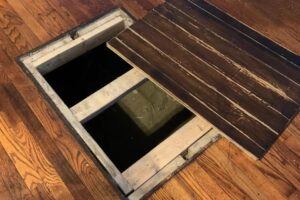A questioner asked:
An opening in the bottom floor of an 1850s home in Charleston, SC! What is this used for?
Some of the answers were:

Probably just an way to access your crawlspace, there’s usually plumbing, wiring and potentially ductwork that periodically may need maintenance -I agree. Sometimes the simplest answer is the correct one.
This is it. My house in Virginia, built in 1949, had this access as well.
Can confirm. Grew up in a farm house build in the early 1800s. My dad and I found access panels like this in the kitchen and bathroom, both of which opened up to water pipe connections with in line shutoffs.
Also in older houses sometimes this would be used for cooling drinks. An old house we once had, had a little box with beer in it. Kept them quite chilled.
It could also be to cover up a floor register from an old central heat system.My grandmother lives in a house built in about 1890 that was fitted with central heating in the 1940s that has absolutely massive floor vents
definitely crawlspace access. new wood framing. if it’s an old house and it got remodelled they probably put it in to get to plumbing and electrical easier. I’ve worked in Charleston for years, we put these in all the time, the houses sink and the exterior access gets blocked or it’s a long crawl from the wall.
Agree you can see outline of it around the hole. That black is where the lip of the grate sat.Also the screws and 2×4’s look newer and the flooring on the cover doesn’t match the original floor.
3 story home built in the 1850s near downtown Charleston has a ~2×3′ opening on the bottom floor. The crawl space underneath is around 3 feet deep and spans almost the full area of the home.
Probably cold storage for vegetables and canned foods. If it was built in 1850 it’s unlikely that it had indoor plumbing that would make it necessary to access pipes. It would sometimes become necessary to add additional support to walls and floors, commonly done by shoring up whatever needed support from the crawlspace.
I was an insulator for a year and had to insulate crawl spaces which meant going in them. They were all usually 1.5 to 4 feet deep with full coverage of the house, most likely just access to anything under the house. If you ever decide to go in there I’d say just watch out for bugs, spiders like living down there.
Bet your local historical society would be able to help you with your specific house!
More than likely an early fridge. I think old homes had those to keep vegetables cool instead of leaving them in the counter. Kind of like a root cellar
From Charleston and have experience lots of experience in the local archaeology and a little in architecture.I can’t speak to the furnace idea one way or another, but I haven’t encountered anything like that before. But it’s not uncommon to find indoor access to the crawl space as they made as a somewhat approximation of a root cellar/wine cellar. It’s also possible that at one time it had a cistern underneath and that was the way to access it.
Quick question from a Brit. Why the prevalence of crawlspaces in US homes? They aren’t something you tend to find in the UK. In fact any home built after WW2 probably wouldn’t have a basement either.
I live in South Carolina, not too far from Charleston. Older houses usually have crawl spaces, but many newer houses are being built on concrete slabs, which is much cheaper.
? Every house I’ve owned in the UK has a crawl space.The American houses seem to have bigger crawlspaces on the whole but there has been a foot or two crawlspace under every British house I’ve been in. It’s just a product of how houses are built, joists laid on foundation walls. In UK homes it’s where most of the central heating pipes go.We call it a crawl space in the UK but no chance you’d be able to actually crawl in it, they’re often blocked by foundation walls and not very deep. I’ve seen some you could (almost like a 4-5 foot basement) but only on old three/four story tenement buildings because of the large and deep foundations.
Located in the doorway, my guess is that was once a gravity floor furnace.
It’s already been said, but it’s definitely the remnants of a floor furnace. My dad is a contractor that has restored many old houses, and said there’s no way this would be an access to a crawlspace (the board in the way would make the opening too small). His current home was built in the late 19th century and had a similar hole in the floor. I’ve attached an image that shows an old floor furnace (note the similar board as your pic, OP). Hopefully this goes through, I’m not great at the imgur thing.
I can all but promise it’s where the old heater grate was located. Back in the day this was the ideal location for the heater because it’s central to the living spaces. If it was for access then it would have been in a area that is off to the side.
I have removed a few of these in the last few years.
On old floor furnace was there before a remodel. Especially if center of house.
Most antebellum homes had coal furnaces that came up through a grate where that would be, but clearly the ground is too shallow for that, so it’s either an easy access created by a central heat and air person, or it’s what’s left of a gas furnace that very well would have fit there that is no longer there.I’m thinking the gas furnace, because the wood is clearly newer, so it’s not original meaning they would have to match best they could with newer flooring.
This is a cover to an old heater space in a 1950s ranch home. Usually located in a central hallway. In some houses it is converted to air intake on a retrofit HVAC unit but original purpose was a floor heater location. Crawl space access is typically from the outside and should not open (in most cases) to the interior. I’ve worked on two houses with this – the first one had used it as the HVAC return so I had to have a grate custom made. The second had the HVAC in a closet so I just made a patch in the wood floor and after refinishing looks like nothing was ever there!Anyway both houses were 1956-1957 and in the southern US if that helps.
Happy renovations!
I very clearly remember one of these from my babysitter’s house. When I was about age 5, my babysitter — an elderly lady in an old house — had a floor grate like this for floor heat from the basement underneath.I very clearly also remember melting a plastic toy on it and getting into a lot of trouble.
Looks like where a furnace used to be. Crawlspace access is normally on the outside of the house.
At my grandmother’s house they had a hole like that under the house. They kept food like apples and vegetables in there. Is it close to the kitchen or pantry





